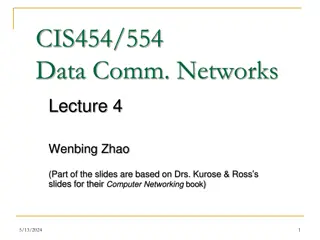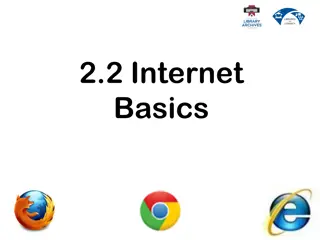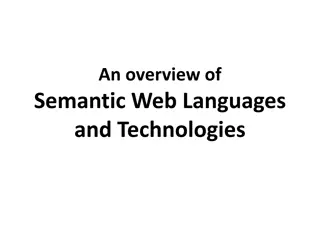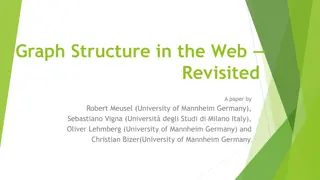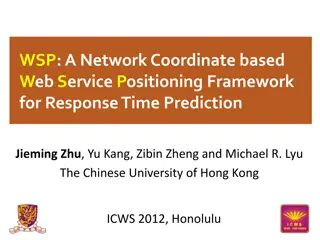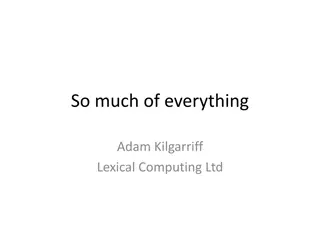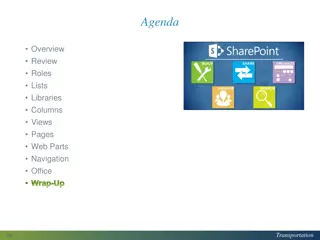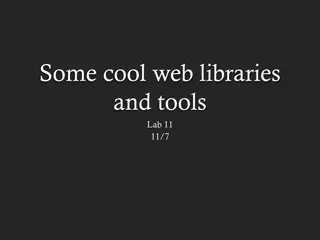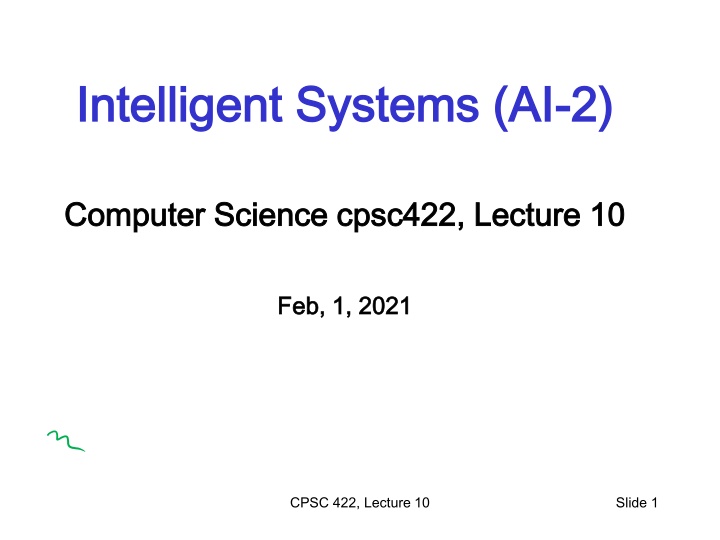
Exploration vs Exploitation in AI and Q-Learning Strategies
Dive into the world of intelligent systems and AI with a focus on reinforcement learning techniques, such as exploration versus exploitation and Q-learning strategies. Understand how agents balance exploiting known information and exploring new possibilities to optimize decision-making. Explore concepts like on-policy learning, scalability, and effective exploration strategies like epsilon-greedy and soft-max. Discover how Q-learning empowers agents to make decisions by exploiting learned Q-functions and the importance of greedy strategies. Join the lecture to unravel the complexities of AI systems and enhance your understanding of machine learning algorithms.
Download Presentation

Please find below an Image/Link to download the presentation.
The content on the website is provided AS IS for your information and personal use only. It may not be sold, licensed, or shared on other websites without obtaining consent from the author. If you encounter any issues during the download, it is possible that the publisher has removed the file from their server.
You are allowed to download the files provided on this website for personal or commercial use, subject to the condition that they are used lawfully. All files are the property of their respective owners.
The content on the website is provided AS IS for your information and personal use only. It may not be sold, licensed, or shared on other websites without obtaining consent from the author.
E N D
Presentation Transcript
Intelligent Systems (AI Intelligent Systems (AI- -2) 2) Computer Science cpsc422, Lecture 10 Computer Science cpsc422, Lecture 10 Feb, 1, 2021 Feb, 1, 2021 CPSC 422, Lecture 10 Slide 1
Lecture Overview Lecture Overview Finish Reinforcement learning Exploration vs. Exploitation Exploration vs. Exploitation On-policy Learning (SARSA) Scalability CPSC 422, Lecture 10 2
CPSC 422, Lecture 8 Slide 3
CPSC 422, Lecture 8 Slide 4
CPSC 422, Lecture 8 Slide 5
Also keep the CPSC 422, Lecture 10 6
What Does Q-Learning learn Q-learning does not explicitly tell the agent what to do . Given the Q-function the agent can . either exploit it or explore more . Any effective strategy should be greedy in the limit of infinite exploration (GLIE) Try each action an unbounded number of times Choose the predicted best action in the limit We will look at two exploration strategies -greedy soft-max CPSC 422, Lecture 10 7
- -greedy greedy Choose a random action with probability and choose best action with probability 1- First GLIE condition (try every action an unbounded number of times) is satisfied via the random selection What about second condition? Select predicted best action in the limit. reduce overtime! CPSC 422, Lecture 8 8
Soft-Max Takes into account improvement in estimates of expected reward function Q[s,a] Choose action ain state s with a probability proportional to current estimate of Q[s,a] [ , ] Q s a e a [ , ] Q s a e CPSC 422, Lecture 8 9
Soft-Max When in state s, Takes into account improvement in estimates of expected reward function Q[s,a] for all the actions Choose action a in state s with a probability proportional to current estimate of Q[s,a] ] , [ a [ , / ] a Q s a Q s e e a [ , ] Q s a [ , / ] a Q s e e (tau) in the formula above influences how randomly values should be chosen if is high, >> Q[s,a]? A. A. It will mainly exploit B. B. It will mainly explore C. C. It will do both with equal probability CPSC 422, Lecture 10 10
Lecture Overview Lecture Overview Finish Reinforcement learning Exploration vs. Exploitation On On- -policy Learning (SARSA) policy Learning (SARSA) RL scalability RL scalability CPSC 422, Lecture 10 11
Learning before vs. during deployment Our learning agent can: A. act in the environment to learn how it works (before deployment) B. Learn as you go (after deployment) If there is time to learn before deployment, the agent should try to do its best to learn as much as possible about the environment even engage in locally suboptimal behaviors, because this will guarantee reaching an optimal policy in the long run If learning while at work , suboptimal behaviors could be costly CPSC 422, Lecture 10 12
Example Example Six possible states <s0,..,s5> 4 actions: UpCareful: moves one tile up unless there is wall, in which case stays in same tile. Always generates a penalty of -1 Left: moves one tile left unless there is wall, in which case stays in same tile if in s0 or s2 Is sent to s0 if in s4 Right: moves one tile right unless there is wall, in which case stays in same tile Up: 0.8 goes up unless there is a wall, 0.1 like Left, 0.1 like Right -1 -1 + 10 -1 -100 -1 -1 -1 Reward Model: -1 for doing UpCareful Negative reward when hitting a wall, as marked on the picture +10 for left in s4 CPSC 422, Lecture 8 13
Example Consider, for instance, our sample grid game: -1 -1 + 10 -1 the optimal policy is to go up in S0 But if the agent includes some exploration in its policy (e.g. selects 20% of its actions randomly), exploring in S2 could be dangerous because it may cause hitting the -100 wall -1 -100 -1 -1 No big deal if the agent is not deployed yet, but not ideal otherwise Q-learning would not detect this problem It does off-policy learning, i.e., it focuses on the optimal policy On-policy learning addresses this problem CPSC 422, Lecture 10 14
On-policy learning: SARSA On-policy learning learns the value of the policy being followed. e.g., act greedily 80% of the time and act randomly 20% of the time Better to be aware of the consequences of exploration has it happens, and avoid outcomes that are too costly while acting, rather than looking for the true optimal policy SARSA So called because it uses <state, action, reward, state, action> experiences rather than the <state, action, reward, state> used by Q-learning Instead of looking for the best action at every step, it evaluates the actions suggested by the current policy Uses this info to revise it CPSC 422, Lecture 10 15
On-policy learning: SARSA In Q-learning we assume that the agent in s will follow the optimal policy . + + [ , ] [ , ] (( max a [ , ' s ' ]) [ , ]) Q s a Q s a r Q a Q s a ' Given an experience <s,a,r,s ,a >, SARSA updates Q[s,a] seeing that the current policy has selected a so how we update? CPSC 422, Lecture 10
-1 -1 + 10 -1 + + [ , ] [ , ] ( [ , ' s ] ' a [ , ]) Q s a Q s a r Q Q s a -1 -100 s0 0 0 0 0 s1 0 0 0 0 s2 0 0 0 0 s3 0 0 0 0 s4 0 0 0 0 s5 0 0 0 0 Q[s,a] upCareful Left Right Up k=1 k=1 -1 -1 + + [ , ] [ , ] ( 9 . 0 = [ , ] [ , ]); Q s right Q s right r Q s UpCareful Q s right 0 0 1 0 k 0 ( 1 + 9 . 0 + ) 0 [ , ] 0 * 0 0 Q s right 0 + 9 . 0 + [ , ] [ , ] ( = [ , ] [ , ]); Q s upCarfull Q s upCarfull r Q s UpCareful Q s upCarfull 1 1 3 1 k ( 1 + 9 . 0 + ) 0 [ , ] 0 1 * 0 1 Q s upCarfull 1 + 9 . 0 + [ , ] [ , ] ( = [ , ] [ , ]); Q s upCarfull Q s upCarfull r Q s Left Q s upCarfull 3 3 5 3 k ( 1 + 9 . 0 + ) 0 [ , ] 0 1 * 0 1 Q s upCarfull 3 Only immediate rewards are included in the update, as with Q-learning + + [ , ] [ , ] ( 9 . 0 = [ , ] [ , ]); Q s Left Q s Left r Q s left Q s Left 5 5 4 5 k 0 ( 1 + 9 . 0 + ) 0 [ , ] 0 * 0 0 Q s Left 5 + + [ , ] [ , ] ( 9 . 0 = [ , ] [ , ]); Q s Left Q s Left r Q s Right Q s Left 4 4 0 4 k 17 ( 1 + 9 . 0 + ) 0 [ , ] 0 10 * 0 10 Q s Left CPSC 422, Lecture 10 4
-1 -1 + 10 -1 + + [ , ] [ , ] ( [ , ' s ] ' a [ , ]) Q s a Q s a r Q Q s a -1 -100 s0 0 0 0 0 s1 -1 0 0 0 s2 0 0 0 0 s3 -1 0 0 0 s4 0 10 0 0 s5 0 0 0 0 Q[s,a] upCareful Left Right Up k=1 k=2 -1 -1 SARSA backs up the expected reward of the next action, rather than the max expected reward + 9 . 0 + [ , ] [ , ] ( [ = , ] [ , ]); Q s right Q s right r Q s UpCareful Q s right 0 0 1 0 k / 1 + 9 . 0 + ) 1 ) 0 9 . 0 [ , ] 0 0 ( 2 * ( Q s right 0 + 9 . 0 + [ , ] [ , ] ( [ , ] [ , ]); Q s upCarfull Q s upCarfull r Q s UpCareful Q s upCarfull 1 1 3 1 k / 1 + 9 . 0 + ) 1 ) 1 + = . 1 [ , ] 1 ( 2 1 * ( 45 Q s upCarfull 1 + + [ , ] [ , ] ( 9 . 0 = [ , ] [ , ]); Q s upCarfull Q s upCarfull r Q s Left Q s upCarfull 3 3 5 3 k / 1 + 9 . 0 + ) 1 + [ , ] 1 ( 2 1 * 0 1 Q s upCarfull 3 + 9 . 0 + [ , ] [ , ] ( [ , ] [ , ]); Q s Left Q s Left r Q s left Q s Left 5 5 4 5 k / 1 + 9 . 0 + ) 0 = [ , ] 0 0 ( 2 * 10 5 . 4 Q s Left 5 + + [ , ] [ , ] ( 9 . 0 [ , ] [ , ]); Q s Left Q s Left r Q s Right Q s Left 4 4 0 4 k 18 / 1 + 9 . 0 + = [ , ] 10 ( 2 10 * 0 10 ) 10 Q s Left CPSC 422, Lecture 10 4
Comparing SARSA and Q-learning For the little 6-states world Policy learned by Q-learning 80% greedy is to go up in s0 to reach s4 quickly and get the big +10 reward Iterations Q[s0,Up] Q[s1,Up] Q[s2,UpC] Q[s3,Up] Q[s4,Left] Q[s5,Left] 40000000 19.1 17.5 22.7 20.4 26.8 23.7 -1 -1 + 10 -1 -1 -100 -1 -1 19 CPSC 422, Lecture 10
Comparing SARSA and Q-learning Policy learned by SARSA 80% greedy is to go right in s0 Safer because avoid the chance of getting the -100 reward in s2 but non-optimal => lower Q-values Iterations Q[s0,Right] Q[s1,Up] Q[s2,UpC] Q[s3,Up] Q[s4,Left] Q[s5,Left] 40000000 6.8 8.1 12.3 10.4 15.6 13.2 -1 -1 + 10 -1 -1 -100 CPSC 422, Lecture 10 -1 -1 20
SARSA Algorithm This could be, for instance any - greedy strategy: -Choose random times, and max the rest CPSC 422, Lecture 10 21
Another Example Gridworld with: Deterministic actions up, down, left,right Start from S and arrive at G (terminal state with reward > 0) Reward is -1 for all transitions, except those into the region marked Cliff Falling into the cliff causes the agent to be sent back to start: r = -100 S G 22 CPSC 422, Lecture 10
With an -greedy strategy (e.g., =0.1) A. SARSA will learn policy p1 while Q-learning will learn p2 B. Q-learning will learn policy p1 while SARSA will learn p2 C. They will both learn p1 D. They will both learn p2 S G 23 CPSC 422, Lecture 10
Q-learning vs. SARSA Q-learning learns the optimal policy, but because it does so without taking exploration into account, it does not do so well while the agent is exploring It occasionally falls into the cliff, so its reward per episode is not that great SARSA has better on-line performance (reward per episode), because it learns to stay away from the cliff while exploring But note that if 0, SARSA and Q-learning would asymptotically converge to the optimal policy CPSC 422, Lecture 10 24
Final Recommendation If agent is not deployedit should do . random all the time ( =1) and Q-learning When Q values have converged then deploy If the agent is deployed it should apply one of the explore/exploit strategies (e.g., =.5) and do Sarsa Decreasing over time CPSC 422, Lecture 10 25
NOT REQUIRED for 422! Map of reinforcement learning algorithms. Boxes with thick lines denote different categories, others denote specific algorithms CPSC 422, Lecture 8 Slide 27
StarAI StarAI (statistical relational AI) (statistical relational AI) Hybrid: Hybrid: Det Det + +Sto Sto 422 big picture 422 big picture Parsing Parsing Prob Prob CFG CFG Prob Prob Relational Models Relational Models Markov Logics Markov Logics Deterministic Deterministic Stochastic Stochastic Belief Nets Belief Nets Approx. : Gibbs Approx. : Gibbs Logics Logics First Order Logics First Order Logics Markov Chains and HMMs Markov Chains and HMMs Forward, Viterbi . Forward, Viterbi . Approx. : Particle Filtering Approx. : Particle Filtering Ontologies Ontologies Query Query Undirected Graphical Models Undirected Graphical Models Markov Networks Markov Networks Conditional Random Fields Conditional Random Fields Full Resolution Full Resolution SAT SAT Markov Decision Processes and Markov Decision Processes and Partially Observable MDP Partially Observable MDP Planning Planning Value Iteration Value Iteration Approx. Inference Approx. Inference Reinforcement Learning Reinforcement Learning Representation Representation Reasoning Reasoning Technique Technique Applications of AI Applications of AI CPSC 422, Lecture 35 Slide 28
Learning Goals for todays class You can: Describe and compare techniques to combine exploration with exploitation On-policy Learning (SARSA) Discuss trade-offs in RL scalability (not required) CPSC 422, Lecture 10 Slide 29
TODO for Wed Read textbook 6.4.2 Next research paper will be next Mon Practice Ex 11.B Assignment 1 due on Wed CPSC 422, Lecture 10 Slide 30

